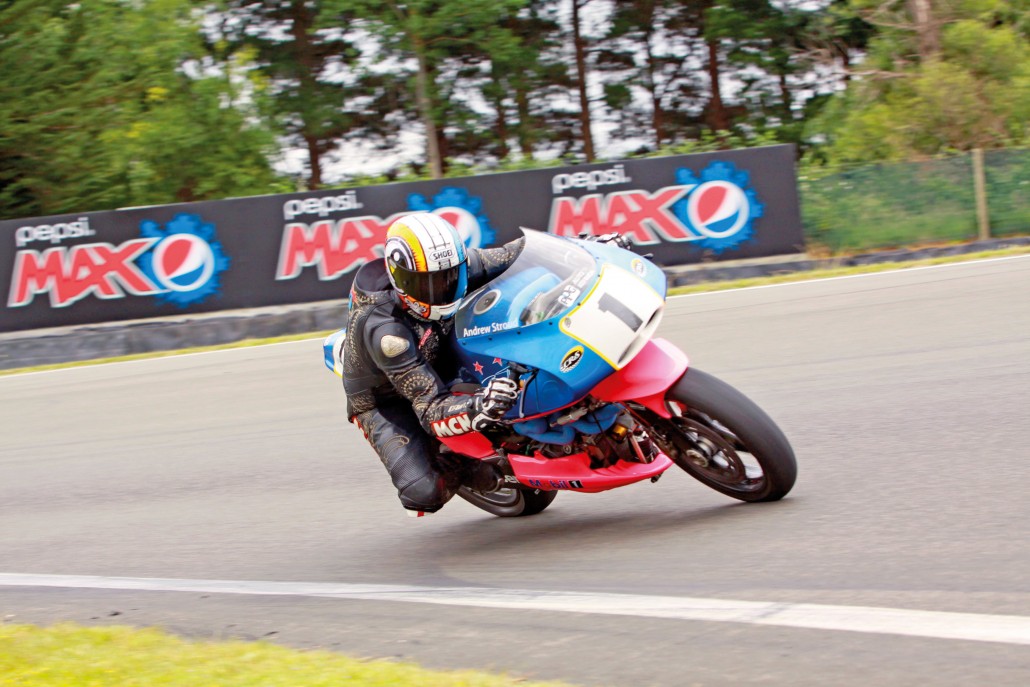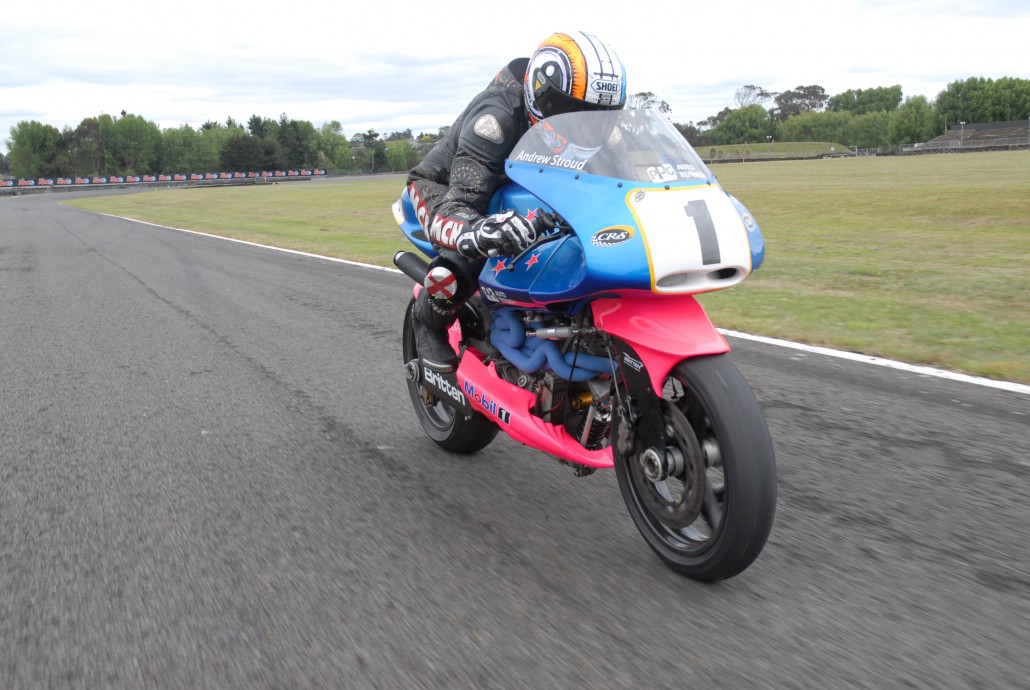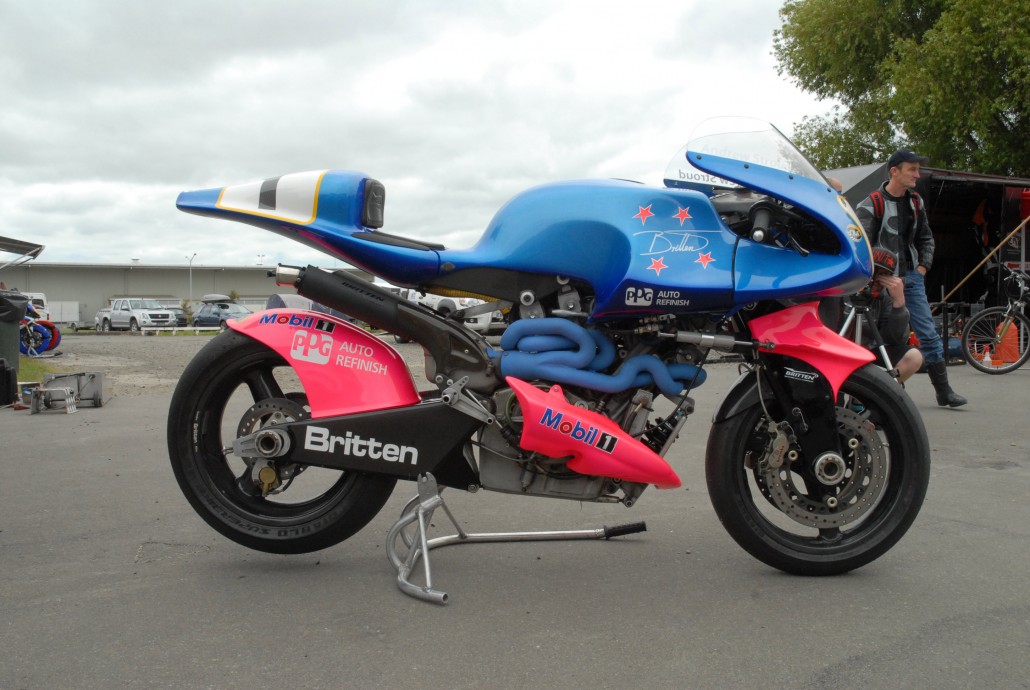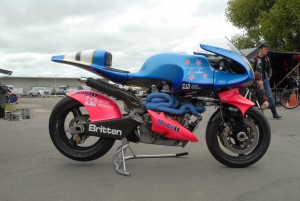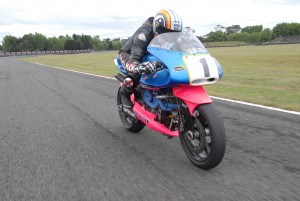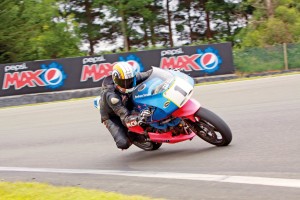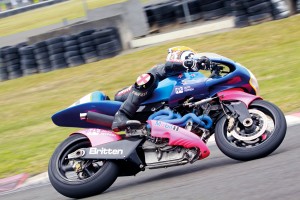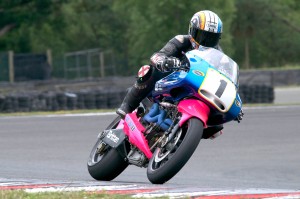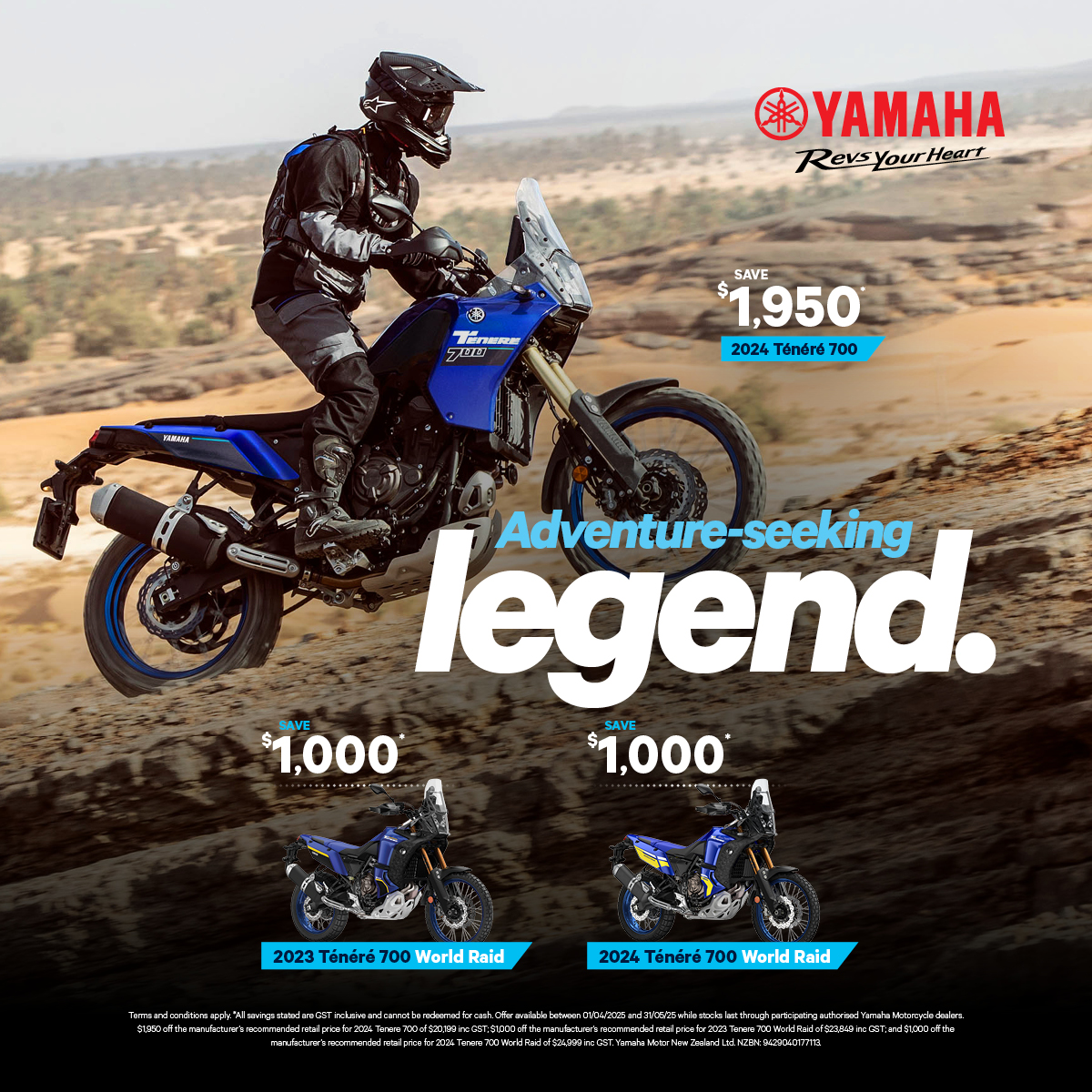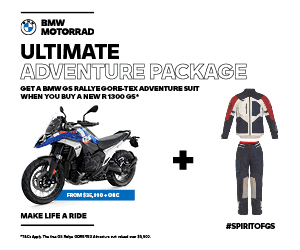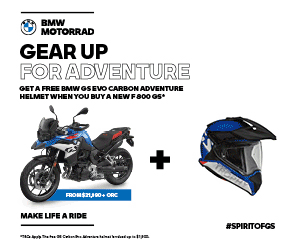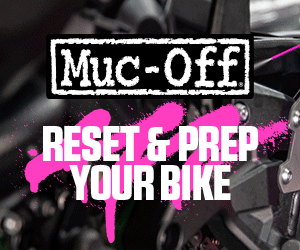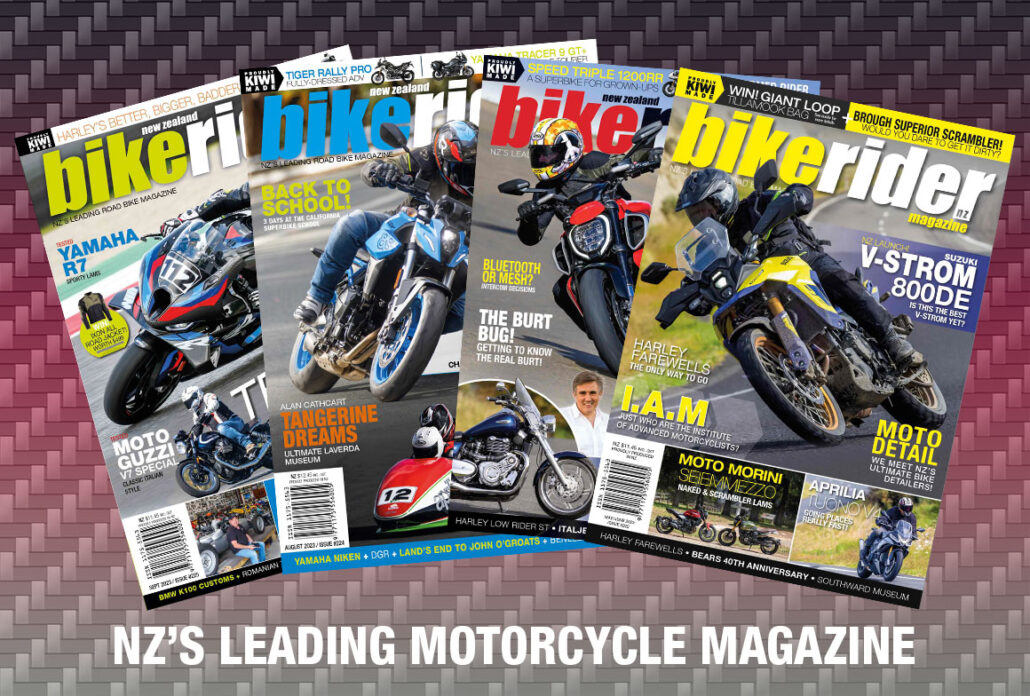V1000 Britten
The Best There Has Ever Been?
When Chad (Adam Child) from British publication Motorcycle News (MCN) got in touch with BRM early in 2012, he had two things on the wish-list he thought BRM might be able to help with. Warming up with riding at Cemetery Circuit on a Post Classic, we thought – yep, pretty sure we can sort that. It was the – “do you reckon you could organise a ride on the Britten?” – that nearly had coffee sprayed all over the keyboards. Naturally the answer was – possibly.
And so the project started. The owner of the BEARS World Championship winning Britten is Kevin Grant, one of life’s good bastards and keeper of many things relating to the irreplaceable history of New Zealand motorcycling on the world stage. Fortunately for Chad, Kev saw this as a good opportunity to have the Britten back on centre stage in the European press – as long as he respected what the Britten means to Kiwis. We informed Chad that it’s not ‘like’ a shrine to Kiwis – it’s the real deal. So, promising to wash his leathers before sitting upon the Britten and reassuring Kevin that he would be respectful, the scene was set. Here’s Chad’s tale of fulfilling his own Britten Dream…
From Bedroom Wall To Manfeild
Outstanding, amazing, one-off special; work of art, all words we used to describe exotic bikes, but we need to invent a new word to describe the V 1000 Britten. In many peoples’ minds it’s simply the greatest bike ever!
For me it’s something special, a dream bike, the poster race bike I had on my bedroom wall. Since I first saw pictures of the sexy bike in the early 90’s I’ve been fascinated by the unusual hand built race bike. They took on the factory teams with huge budgets and won, all from a garage at John’s house, unthinkable in the early 90’s.
Now make yourself a brew, turn off your mobile phone and sit down, this is one of the greatest bike build stories ever, Hollywood couldn’t even script this true tale.
The Tale Of Awe
I’ll try not to go into too much technical detail, nor will I try to get too emotionally involved. John Britten, the creator of the Britten, was a bike racer but also a gifted engineer, designer and a bit of a maverick. The man designed and built his own house from mainly recycled material as he couldn’t find what he was looking for and wanted to save money. He raced successfully in NZ but was always experimenting with chassis design and engines in the late 80’s – you could never describe him as an ‘off the shelf’ racer. John’s dilemma was he knew what he wanted, but nobody produced the bike, or parts he wanted. So John stuck two fingers up to the motorcycling world and said – sod it, I’m going to produce my own bike, build the lot from scratch.
Not only would he produce a stunning motorcycle but it was competitive on the world stage and took the World BEARS title in 95, after it had already led at Daytona and won numerous NZ titles and FIM world speed records. Can you possibly imagine that today? One man and a few gifted friends getting together in a garage in Christchurch, then turning up at an international meeting at Daytona, America or the Isle of Man with a bike which doesn’t use components from any other bike, doesn’t use a donor engine, everything is bespoke, and a mammoth leap forward in terms of engineering. Then not only does the bike run and handle, almost unbelievably it’s immediately competitive and fast, contesting at the front against factory bikes. It was around 145kg; considerably lighter than the competition at the time from factory teams. It lead at Daytona, but only a few laps from the end the rectifier gave up, one of the only parts John didn’t design, and it recorded the fastest speed at the Isle of Man on its debut in 1993 at 165mph. It normally takes years of development to achieve that level, even with factory backing, a team of engineers and significant financial backing.
In the early 90’s John produced the Britten which you see in front of you today. Only nine exist world-wide and most are museum pieces (10 were built but one was destroyed in a tragic crash at the IOMTT).
Now take a closer look at the bike you see in front of you. That’s right – no conventional front forks, no conventional rear shock or cooling and that’s a huge 1000 V-Twin. The powerful 160bhp plus engine isn’t stolen from a Harley or Ducati, the Italians were still playing with the 888. John made his own engine, designed and built in NZ. Everything from the casings to the pistons, even the fuel injection system, and this was when fuel injection was virtually unheard of on a bike. They were making and programming their own home made ECU back in the early ‘90s!
Just think about that for a moment, designing and building your own engine at home. John and the team had to work out the sizes of the valves, cam timings, pistons sizes, crank rotation, cooling, oil flow etc, all those calculations had to be done. Then building it, producing his own casings in his garage, making a crank, working out the strengths of the components, it’s unimaginable what the team achieved. In total there was around 6000 different parts, all designed and built just for this engine – and they had to work together perfectly to withstand racing at the toughest, most demanding tracks in the world. It takes me three hours to put up a shelf, how the hell did he do it? It’s unthinkable.
It didn’t just stop at the engine; chassis design (or lack of chassis) was all John’s idea, as the engine is the main part of the chassis, like Ducati’s new Panigale or a modern MotoGP bike, but this was 20 years ago. The front suspension bolts to the front of the motor, the swing-arm to the rear. There’s no conventional front forks; but a solid piece of carbon fibre handmade by John, connected to the motor via a series of linkages with a single Öhlins adjustable shock. Everything is easily adjustable, like the rake and trail with a twirl of an Allen key. The rear shock is at the front, near the front wheel, away from any heat from the engine or exhaust, therefore stays constant, and is connected by a rod to the rear carbon fibre swing-arm under the bike. It really is a work of art. Everything was built by John and his small team, the bodywork all clay moulded and carbon fibre, this is also when carbon fibre was for F1 only, all new and exciting. Even the wheels are carbon fibre made and designed by John’s team, originally starting out as just small hand woven strands, outstanding.
It wasn’t just a breath-taking demonstration of one man’s’ thinking, working together with a gifted team, the Britten worked and worked well. In NZ it took national titles, led at Daytona followed by a world BEARS title and the ultimate challenge, the TT.
This is where my love affair started at the TT back in 1994. I was young and naive but my older brother and father are both engineers and would discuss and chat about the Britten until the early hours. They were mesmerised by the bike like everyone was. It was almost alien, using technology and design’s unheard of at the time.
Dream Weaver
Finally, today my dream has come true. I’ve travelled from the other side of the world, to Manfeild, to actually ride the Britten. I’m going to join a very small select group of individuals. It’s taken nearly a year of organising, begging and pleading but eventually I’m here, in sunny NZ and this is my moment.
Kevin Grant, the owner is a real character. He shakes my hand firmly and gives me a knowing smile, right behind him is the actual BEARS title winning Britten in all its glory. ‘You’re a lucky bugger, you know boy, there’s a list as long as my arm of people who want to ride the Britten’. We instantly click and talk about the old days of racing and TT stories. Kevin has a brilliant collection of bikes, some priceless, and has travelled the world to build his collection, but he’s down-to-earth, it’s a pleasure to be in his company. “Right, me boy, make yourself look smart and I’ll fire up my baby for you!”
As I get into race leathers in the scorching heat, the excitement is really building. It started when I got off the plane two days ago, and now my heartbeat is racing, I’m about to ride the priceless Britten, worth around a million NZ dollars but priceless in historic terms. I walk over to the Britten and am greeted by Kevin saying “Bloody hell, you’ve got some fancy leathers; almost looks like you know what you’re doing.” He seems relaxed considering he’s about to let an unknown Yorkshireman ride his pride and joy.
The remote engine starter slowly starts to turn the huge rear Pirelli slick on the Britten, there is a slight misfire, but then she barks into life, puffing out a little blue smoke from the unburned oil. What a bark – stand behind the Britten and the compression nearly blows you over! Kevin blips the throttle to slowly warm up the huge V-Twin.
Sweat is pouring down my back as I stand patiently next to the angry Britten. Kevin gives me the nod, and I take the throttle and blip the twist grip, bringing the old racer up to temperature. It’s like Kevin has passed me the Holy Grail, I’m getting a bit dusty-eyed just standing here warming up the legendary race bike which is a key part of racing history. This is the only Britten remaining on the planet that still does laps, thanks to Kev’s association with the men who originally worked on it making it possible to be kept running.
The stunning Britten is gently lowered from its central paddock stands with the same care a mother would take to lower a newborn baby into a cradle. I gently lever my leg over the tall tail unit, making sure I don’t scratch her, and get myself into position. The heat from under-seat radiator combined with the exhaust routing is slowly cooking my left testicle but I don’t mind – I’ll sacrifice a ball to ride the Britten. We get the nod that the track is clear and it’s my turn to enter the Manfeild circuit, home to the final round of the inaugural WSB series, another box ticked.
THE Moment!
Pit lane is full of envious racers who’ve taken an early and extended lunch from race practice to allow me to ride the Britten, I have the track to myself. I’m so nervous; crashing the Britten in front of a few hundred dedicated Kiwi Britten fans would be a fate worse than death, or possibly amount to the same thing.
I pull in the heavy slipper clutch, up one on the smooth race shift, build the revs to 5-6000rpm (please don’t stall) and we’re away. Pit lane is a burble of noise as the twin-exit exhausts growl down pit lane, echoing back and forth from the garages. I have to slip the clutch slightly as she’s not happy to be ridden at such a pedestrian rate; she’s a thoroughbred who wants to be let loose.
I give her a little dab of throttle and there’s instant power from the V-Twin, sharp and snatchy, she wants to run. Up to third gear on the little straight, only short shifting at first, getting dialled in. Slowly I negotiate the infield and up to the t left hand hairpin, I know the straight is coming up, I know the race Pirelli slicks are up to temperature, you’ve travelled half way around the world for this moment, tuck in and give her some.
I sit the Britten upright on the exit, feel the rear Pirelli dig in and wind on the vicious power. The front goes light as the power kicks in, she’s less than 150kg wet and with a short wheelbase (same as an Aprilia RSV 4 shorter than a Ducati Panigale) she wants to perform for the admiring crowd. Time to jump on the Brembo stoppers, back to second gear and the feeling is strange. There’s around 5mm of dive but that’s about it as the Brembo stoppers take hold of the 320mm front discs. Again considering the age of the bike the stoppers are really impressive, but what’s more impressive is the feel even with the lack of dive. You can feel the level of grip which means you can squeeze harder; which just allows the rear to go light as the slipper clutch takes over, this is all very impressive for a bike nearly 20 years old.
She turns in with incredible ease, and the large bodywork allows you to hang off the inside of the bike, knee just brushing the warm NZ track. On the back straight it’s once again time to feel the power and let her loose as the exhausts echo around the track. There’s a lovely induction noise from the huge bell mouths, incidentally made from carbon fibre and designed by John. This is heaven, simply heaven, the stuff of dreams.
Out of the final turn you’re automatically thrown wide towards the pit wall, which is covered in race fans leaning over to witness the Britten in full flow which is rare even in its native country. With my knee slider barley brushing the historic track, I sit her up on the fat part of the Pirelli and dial in the power once more, deliberately letting her drift wide and skim along the pit wall, sending a few onlookers backwards, as I throw in gear after gear, revelling in the sound and knowing I’ve got those amazing stoppers to rely on at the end of the straight. Wow! Does it get any better than this?
As the speed increased so did my confidence in the Britten. She hates to run slowly, doesn’t like the revs to drop below 4,000 and is a little vicious off the bottom-end, but she’s a pure race bike, gloriously so. In the magic curl of power it’s a formidable place to be, the bike is laughing at my feeble speeds, I’m almost embarrassed as I’m getting nowhere near the historic race bike’s potential, but I have to remind myself of the bikes value, not just financial but historical.
I manage a decent number of laps but all too soon the chequered flag comes out and my time is over, if I’ve died and gone to heaven then I’m a happy man. Only on the cool down lap do I notice the heat from the hand crafted exhaust (which took 60hours to make) and the radiator running under the seat. As I slowly make my way up pit lane towards the proud owner he greets me with a smile. As the mechanics take the Britten he reaches over and wipes the petrol tank near my crutch -“You haven’t made a mess have you boy, I told you she wasn’t a cock-tease, you actually can ride this one. You did a few more laps than you said you would, too – you cheeky little git” My hands are shaking, my leathers are soaked in sweat, I look beat. A year of planning and years of dreaming have finally come true.
What is the best bike I have ever ridden?
I feel very privileged to have ridden the Britten, something I’ve always wanted to do and dreamed about, it’s a huge piece of biking history which will never be repeated. I’ve been professionally testing bikes for over ten years now, I’m fortunate enough to have ridden Moto GP bikes old and new, winning WSB and BSB bikes and other historic bikes but for me, personally to ride the Britten in NZ is the one. Now when people ask what the best bike I’ve ever ridden I now have an answer – the Britten.
I had just joined a select group who have ridden the Britten. This list consists of the original riders plus such legends as Hugh Anderson, Paul Smart and John Surtees – A memory to be cherished for a lifetime.
Respect
Guy Martin – “I don’t own much but I’ll sell everything I have to own one! I will have one, one day. The Britten is simply the best bike ever, full stop! It’s the bike all others should be measured by.
Kenny Roberts – “John Britten must be the greatest bike builder of all time.”
Philip McCallen – works Honda RC45 rider: “ I knew about the Britten, I’d read about the bike and heard it was fast, it was clocked at 190mph at Daytona or something like that so I knew it would be quick. I can remember following it at the North West before the TT and thought that’s quick, it was a very quick bike.”
“In ‘94 we had the new RC45 from Honda, one for me, one for Hizzy (Steve Hislop) and one for Joey (Dunlop). They were my main rivals in the factory team and I was so desperate to beat Hizzy. The Britten was the dark horse, the one we kept an eye on, a sideways glance. I can remember giving it a look-over at the time, as I’m an engineer, and thought it looked a bit agricultural at first. But once you start to look closer – it was a lovely piece of engineering. During the first week of practice I was always looking at it through the corner of my eye, it certainly stood out.
“Sadly, Mark Farmer, who was riding one of the Brittens, was killed on the Thursday practice at Black Dub. He was a good guy and a fast rider. I was the next bike through the wreckage after the crash. It’s an easy place to high-side, I nearly crashed badly there in ‘97 on the power – huge slide on the factory Honda, still unsure how I saved that today. The section goes off camber and you’re trying to dial in the power. After the crash, the spotlight on the Britten dimmed a little, nobody wanted to shout about how great a bike was with a rider who had been killed on it. It’s a shame nothing really came of the Britten, as John passed away due to illness the year after. I think and Shaun Harris had another run – the potential was there, the bike was quick and it was an outstanding piece of engineering and design”.
Nick Jefferies – the fastest man to lap the IOM TT course on a Britten: “The Britten was the scariest bike I’ve ever ridden. To be honest it was light and had so much power it would wheelie everywhere, which was great fun.
John passed away the year after the TT and he sent me a letter before his death, which I’ve still kept – he was such a nice chap. He still felt bad about Mark. He made a plaque for Mark in the same workshop the Britten came out of which I took to the TT in 95. John was a gifted man, he was sheer genius. Can you imagine what type of bike we would be riding around on today if he was still alive? He was so far ahead of his time, a brilliant man.
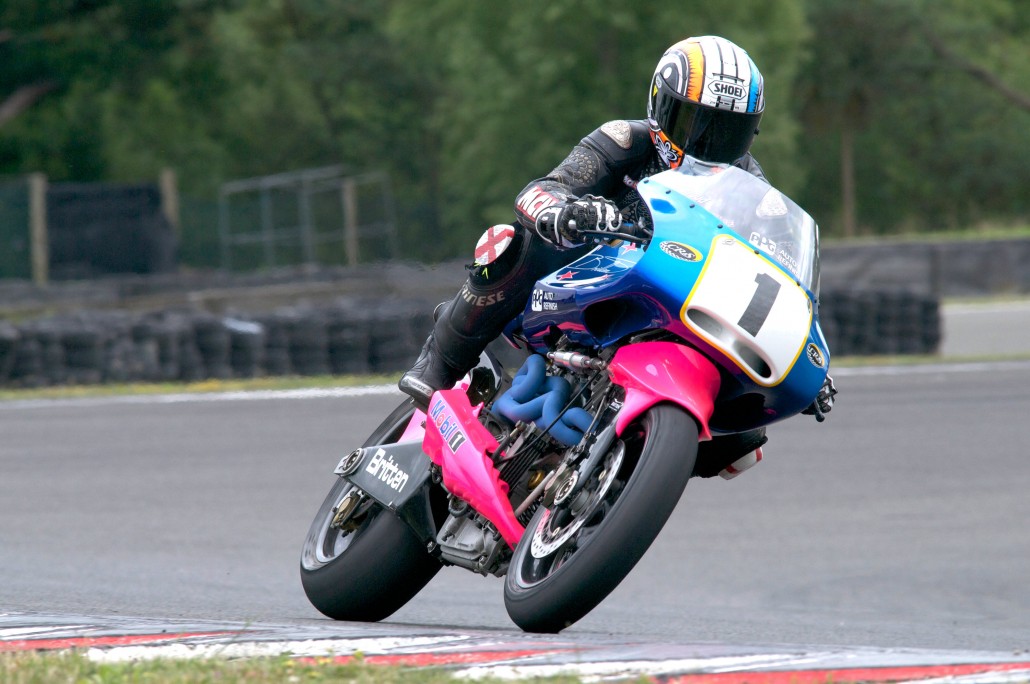
How did you get your hands on the Britten, Kev?
“It was just a quirk of fate really. We were going to a jubilee meeting at Assen, and basically at the end of the day I was trying to organise all the Kiwi riders. I wanted to make a team approach, look professional, and so I contacted Bob Brookland who was a Britten Director but also had a company, a factory who did T-shirts, race shirts and stuff like that. We went through the list, jacket, T-shirts for all the team, around 200 bits of clothing all together, we was chatting for ages I was getting a great deal from a mate. He said after a long conversation, “bloody hell Kev, is there anything else I can do for you?” I said tongue in cheek, “well you can sell me a bloody Britten.” He paused and said “Well the best one has just come available!” It was one of those heart stopping moments I can tell you ,like you had today on the bike, I knew I was going to own it!”
Dare I ask how much you paid for it and where from?
“Sure – you can ask. I bought it direct from the factory, from the Britten Motorcycle Company it had just won the world BEARS championship in 1996. Basically, I’ll say it was the price of a house, a good house (possibly not universally considered a good move within the house at the time…). I got a deal because I said it would stay in NZ and they could use it for a few years at demonstrations and such like.”
You must have had offers to buy the bike?
“Oh yeah, we were at Goodwood in 2005, in the paddock with the F1 cars and all that, and it was getting more attention than them, even from the F1 technicians. For me it was the first time I realised how important it was internationally, not just for Kiwi fans. There are a lot of collectors who want the bike, but I’ve always said it’s simply not for sale, sorry. It’s not worth anything as it’s not for sale, simple as that, it’s a part of NZ history.”
Which bike is yours, as I understand there are nine bikes?
“Mine is the BEARS World Championship winning bike. It won at Daytona, then took second at Monza and won at Thruxton, Zeltweg, Brands Hatch and then Assen as well. The Britten team was first and second that year in the World Championship, not many people know that. “
Details
The bodywork is all carbon fibre, designed and built by John and the team. Originally they made a clay model from a wire metal framework, all done by hand, but using revolutionary aerodynamic designs with help from Christchurch University.
John and the team had the philosophy that each single part should perform two jobs or more. The top fairing has two pairs of induction ducks, one pair to feed air to the intake stacks and one pair to cool the radiator under the seat. Overheating was still the Achilles heel of the Britten. Its placement kept the bike slim and aerodynamic but it struggled a bit in long flat-out sections of the Isle Of Man.
The craftsmanship in the exhaust is unbelievable; it took 60 hours to make and again all designed by John and the team from scratch to provide the flow they had calculated their engine needed for optimum performance, another example of the all-round brilliance found within the Britten team.
Front double wishbone suspension has a single Öhlins shock, which is fully adjustable. You can also adjust the pre-load on the move as the remote pre-load adjuster is next to the rev counter on the carbon dash.
The rear suspension is located in front of the engine, keeping the shock cooler and keeping the mass further forward. There’s a connecting rod to the carbon fibre swing arm underneath the bike.
The 60 degree V-Twin has a huge compression ratio of 13.7:1, and again all designed in house by John and the team. Power ranges from around 155bhp to 170bhp depending on which engine, which cylinder head and what fuel was being used. Brittens were built in both four and five-valve configurations.
The radiator is actually located under the seat. John didn’t want the radiator at the front of the bike as he wanted to keep it narrow and aerodynamic. The flow through the radiator from the frontal ducts and out the rear also reduced the negative pressure zone immediately behind the bike, again aiding aerodynamic efficiency.
The top yoke, which is handmade, also holds the front reservoir, again highlighting John’s philosophy of every part must do two jobs.
The Britten was one of the first race bikes to use fuel injection and an ECU, again all designed by John and the team. On the left bar there are a series of switches, so you can play with the fuelling on the move or press a button to record a problem, a basic telemetry system – back in the early 1990s.
Specifications
Britten V1000
Engine: Liquid cooled, 8-valve (also built in 10-valve configuration)60 degree V-twin, (99x64mm)
Capacity: 985cc
Gearbox: 5 speed
Frame: Engine as fully stressed member, carbon composite frame and suspension components.
Suspension: Double wishbone front suspension with single fully adjustable Öhlins shock. Rear: double wishbone with fully adjustable Öhlins shock.
Fuel Capacity: 24l
Weight 138-145kg depending on model



